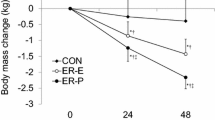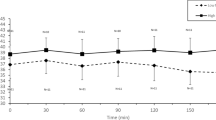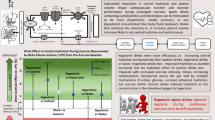Abstract
Background
Investigations of the effect of beverages containing carbohydrates, only, on the sodium and fluid balance during intermittent exercise of high intensity are rare. Therefore, we compared the effects of water and carbohydrate supplementation on plasma, blood volume, and electrolyte shifts during intermittent exercise.
Methods
Ten male subjects performed an intermittent exercise test twice. In one trial, tap water (4 ml/kg/15 min) was consumed (Plac trial). In the other trial, the same amount of water supplemented with maltodextrin to achieve a 9.1 % carbohydrate solution (CHO trial) was ingested. Training schedule: warm-up at 50 % for 15 min. Afterwards, power changed between 100 % of the maximum power from a previous incremental test minus 10 and 10 W for each 30 s. Venous blood was sampled to measure electrolytes, osmolality, [protein], hct, [Lactate], [glucose], [Hb] and catecholamines. Hydration status was evaluated by BIA before and after exercise.
Results
After beverage ingestion [glucose] was significantly higher in CHO until the end of the trial. Starting with similar resting values, osmolality increased significantly more during CHO (p = 0.002). PV decreased by 5 % under both conditions, but recovered partly during exercise under Plac (p = 0.002). [Na+] and [Cl−] decreased with Plac during exercise (both p < 0.001) but remained constant during exercise with CHO.
Conclusions
Sole carbohydrate supplementation seems to stabilise plasma [Na+]. This cannot be explained simply by a cotransport of glucose and [Na+], because that should lead to a recovery of the blood and plasma volume under CHO. In contrast, this was found during exercise with Plac.




Similar content being viewed by others

Abbreviations
- […]cap :
-
Capillary concentration of…
- […]v :
-
Venous concentration of…
- A:
-
Adrenaline
- ANOVA:
-
Analysis of variance
- BIA:
-
Bio impedance analysis
- BV:
-
Blood volume
- CET:
-
Continuous endurance training
- CHO:
-
Carbohydrate
- ECW:
-
Extracellular water
- HIHVT:
-
High-intensity high-volume training
- HIIT:
-
High-intensity interval training
- HIT:
-
High-intensity training
- ICW:
-
Intracellular water
- Kg/bw:
-
Kilogram/body weight
- Min:
-
Minute
- NA:
-
Noradrenaline
- Plac:
-
Placebo = water
- PV:
-
Plasma volume
- TBW:
-
Total body water
- VE:
-
Ventilation
References
Anastasiou CA, Kavouras SA, Arnaoutis G, Gioxari A, Kollia M, Botoula E, Sidossis LS (2009) Sodium replacement and plasma sodium drop during exercise in the heat when fluid intake matches fluid loss. J Athl Train 44:117–123
Baker LB, Lang JA, Kenney WL (2009) Change in body mass accurately and reliably predicts change in body water after endurance exercise. Eur J Appl Physiol 105:959–967
Bangsbo J, Madsen K, Kiens B, Richter EA (1996) Effect of muscle acidity on muscle metabolism and fatigue during intense exercise in man. J Physiol 495(Pt 2):587–596
Burge CM, Skinner SL (1995) Determination of hemoglobin mass and blood volume with CO: evaluation and application of a method. J ApplPhysiol (1985) 79:623–631
Cairns SP, Lindinger MI (2008) Do multiple ionic interactions contribute to skeletal muscle fatigue? J Physiol 586:4039–4054
Clausen T (2003) Na + -K + pump regulation and skeletal muscle contractility. Physiol Rev 83:1269–1324
Clausen T (2010) Hormonal and pharmacological modification of plasma potassium homeostasis. FundamClin Pharmacol 24:595–605
Clifford PS, Hellsten Y (2004) Vasodilatory mechanisms in contracting skeletal muscle. J Appl Physiol 97:393–403
Cope FW (1967) NMR evidence for complexing of Na+ in muscle, kidney, and brain, and by actomyosin. The relation of cellular complexing of Na+ to water structure and to transport kinetics. J Gen Physiol 50:1353–1375
Coyle EF, Hamilton MT, Alonso JG, Montain SJ, Ivy JL (1991) Carbohydrate metabolism during intense exercise when hyperglycemic. J Appl Physiol (1985) 70:834–840
Criswell D, Powers S, Lawler J, Tew J, Dodd S, Iryiboz Y, Tulley R, Wheeler K (1991) Influence of a carbohydrate-electrolyte beverage on performance and blood homeostasis during recovery from football. Int J Sport Nutr 1:178–191
Criswell D, Renshler K, Powers SK, Tulley R, Cicale M, Wheeler K (1992) Fluid replacement beverages and maintenance of plasma volume during exercise: role of aldosterone and vasopressin. Eur J Appl Physiol Occup Physiol 65:445–451
Davis JM, Lamb DR, Pate RR, Slentz CA, Burgess WA, Bartoli WP (1988) Carbohydrate-electrolyte drinks: effects on endurance cycling in the heat. Am J Clin Nutr 48:1023–1030
De Bock K, Derave W, Ramaekers M, Richter EA, Hespel P (2007) Fiber type-specific muscle glycogen sparing due to carbohydrate intake before and during exercise. J Appl Physiol (1985) 102:183–188
de Sousa MV, Simoes HG, Oshiiwa M, Rogero MM, Tirapegui J (2007) Effects of acute carbohydrate supplementation during sessions of high-intensity intermittent exercise. Eur J Appl Physiol 99:57–63
Dill DB, Costill DL (1974) Calculation of percentage changes in volumes of blood, plasma, and red cells in dehydration. J Appl Physiol 37:247–248
Essen B (1978a) Glycogen depletion of different fibre types in human skeletal muscle during intermittent and continuous exercise. Acta Physiol Scand 103:446–455
Essen B (1978b) Studies on the regulation of metabolism in human skeletal muscle using intermittent exercise as an experimental model. Acta Physiol Scand Suppl 454:1–32
Essen B, Hagenfeldt L, Kaijser L (1977) Utilization of blood-borne and intramuscular substrates during continuous and intermittent exercise in man. J Physiol 265:489–506
Fricke G (1965) Über das Verhalten des Zellfaktors bei körperlicher Arbeit. Cardologia 47:25–44
Fritzsche RG, Switzer TW, Hodgkinson BJ, Lee SH, Martin JC, Coyle EF (2000) Water and carbohydrate ingestion during prolonged exercise increase maximal neuromuscular power. J Appl Physiol 88:730–737
Gisolfi CV, Summers RW, Lambert GP, Xia T (1998) Effect of beverage osmolality on intestinal fluid absorption during exercise. J Appl Physiol 85:1941–1948
Gollnick PD, Karlsson J, Piehl K, Saltin B (1974) Selective glycogen depletion in skeletal muscle fibres of man following sustained contractions. J Physiol 241:59–67
Green HJ, Duhamel TA, Holloway GP, Moule JW, Ouyang J, Ranney D, Tupling AR (2007) Muscle Na + -K + -ATPase response during 16 h of heavy intermittent cycle exercise. Am J Physiol Endocrinol Metab 293:E523–E530
Hellsten Y, Nyberg M, Jensen LG, Mortensen SP (2012) Vasodilator interactions in skeletal muscle blood flow regulation. J Physiol 590:6297–6305
Jeukendrup AE, McLaughlin J (2011) Carbohydrate ingestion during exercise: effects on performance, training adaptations and trainability of the gut. Nestle Nutr Inst Workshop Ser 69:1–12
Karelis AD, Peronnet F, Gardiner PF (2002) Glucose infusion attenuates muscle fatigue in rat plantaris muscle during prolonged indirect stimulation in situ. Exp Physiol 87:585–592
Klitzman B, Duling BR (1979) Microvascular hematocrit and red cell flow in resting and contracting striated muscle. Am J Physiol 237:H481–H490
Koulmann N, Jimenez C, Regal D, Bolliet P, Launay JC, Savourey G, Melin B (2000) Use of bioelectrical impedance analysis to estimate body fluid compartments after acute variations of the body hydration level. Med Sci Sports Exerc 32:857–864
Kyle UG, Bosaeus I, De Lorenzo AD, Deurenberg P, Elia M, Gomez JM, Heitmann BL, Kent-Smith L, Melchior JC, Pirlich M, Scharfetter H, Schols AM, Pichard C (2004) Bioelectrical impedance analysis–part I: review of principles and methods. Clin Nutr 23:1226–1243
Lamb DR, Brodowicz GR (1986) Optimal use of fluids of varying formulations to minimise exercise-induced disturbances in homeostasis. Sports Med 3:247–274
Leiper JB, Nicholas CW, Ali A, Williams C, Maughan RJ (2005) The effect of intermittent high-intensity running on gastric emptying of fluids in man. Med Sci Sports Exerc 37:240–247
Lindinger MI, Heigenhauser GJ, McKelvie RS, Jones NL (1990) Role of nonworking muscle on blood metabolites and ions with intense intermittent exercise. Am J Physiol 258:R1486–R1494
Lindinger MI, Heigenhauser GJ, McKelvie RS, Jones NL (1992) Blood ion regulation during repeated maximal exercise and recovery in humans. Am J Physiol 262:R126–R136
Lott ME, Hogeman C, Herr M, Gabbay R, Sinoway LI (2007) Effects of an oral glucose tolerance test on the myogenic response in healthy individuals. Am JPhysiol Heart CircPhysiol 292:H304–H310
Maassen N, Busse MW (1989) The relationship between lactic acid and work load: a measure for endurance capacity or an indicator of carbohydrate deficiency? Eur J Appl Physiol Occup Physiol 58:728–737
Maassen N, Vardaxoglou KFM (2006) The impact of highly intensive interval like training on respiration. European College of Sport Science, 11th Annual Congress, Lausanne
Maassen N, Weis T, Schneider G, Schmidt W (1995) Carbohydrate rich beverages reduce plasma volume decrease during endurance exercise. Dehydration, rehydration and exercise in the heat. An International Conference, Nottingham, England. Abstracts of Poster Presentations, 15
Maassen N, Foerster M, Mairbaurl H (1998) Red blood cells do not contribute to removal of K+ released from exhaustively working forearm muscle. J Appl Physiol (1985) 85:326–332
Maassen M, Kummer O, Chouchakov VMN (2007) Die Wirkung von Kohlenhydratgaben während hochintensiver Intervallarbeit auf den Energiestoffwechsel und den Wasserhaushalt. Kummer O Chouchakov V, Maassen N. 7/8. 2007. Deutsche Zeitschrift für Sportmedizin
Maughan RJ, Meyer NL (2013) Hydration during intense exercise training. Nestle Nutr Inst Workshop Ser 76:25–37
Mayer CU, Treff G, Fenske WK, Blouin K, Steinacker JM, Allolio B (2015) High incidence of hyponatremia in rowers during a four-week training camp. Am J Med 128:1144–1151
Michel CC, Curry FE (1999) Microvascular permeability. Physiol Rev 79:703–761
Murray R, Eddy DE, Murray TW, Seifert JG, Paul GL, Halaby GA (1987) The effect of fluid and carbohydrate feedings during intermittent cycling exercise. Med Sci Sports Exerc 19:597–604
Murray R, Seifert JG, Eddy DE, Paul GL, Halaby GA (1989) Carbohydrate feeding and exercise: effect of beverage carbohydrate content. Eur J Appl Physiol Occup Physiol 59:152–158
Murray B, Stofan J, Eichner E (2003) Hyponatremia in athletes. Sports Sci Exch Gatorate Sports Sci Ins 16:88
Nassis GP, Williams C, Chisnall P (1998) Effect of a carbohydrate-electrolyte drink on endurance capacity during prolonged intermittent high intensity running. Br J Sports Med 32:248–252
Nicholas CW, Tsintzas K, Boobis L, Williams C (1999) Carbohydrate-electrolyte ingestion during intermittent high-intensity running. Med Sci Sports Exerc 31:1280–1286
Nielsen B, Sjogaard G, Bonde-Petersen F (1984) Cardiovascular, hormonal and body fluid changes during prolonged exercise. Eur J Appl Physiol OccupPhysiol 53:63–70
Nielsen HB, Febbraio MA, Ott P, Krustrup P, Secher NH (2007) Hepatic lactate uptake versus leg lactate output during exercise in humans. J Appl Physiol (1985) 103:1227–1233
Noakes TD, Sharwood K, Speedy D, Hew T, Reid S, Dugas J, Almond C, Wharam P, Weschler L (2005) Three independent biological mechanisms cause exercise-associated hyponatremia: evidence from 2,135 weighed competitive athletic performances. Proc Natl Acad Sci USA 102:18550–18555
O’Brien C, Young AJ, Sawka MN (2002) Bioelectrical impedance to estimate changes in hydration status. Int J Sports Med 23:361–366
Petersen HA, Fueger PT, Bracy DP, Wasserman DH, Halseth AE (2003) Fiber type-specific determinants of Vmax for insulin-stimulated muscle glucose uptake in vivo. Am J Physiol Endocrinol Metab 284:E541–E548
Poole DC (2014) Crosstalk opposing view: de novo capillary recruitment in healthy muscle is not necessary to explain physiological outcomes. J Physiol 592:5133–5135
Rippe B (2008) Free water transport, small pore transport and the osmotic pressure gradient three-pore model of peritoneal transport. Nephrol Dial Transplant 23:2147–2153
Rose AJ, Richter EA (2005) Skeletal muscle glucose uptake during exercise: how is it regulated? Physiology (Bethesda) 20:260–270
Ruff RL (1996) Sodium channel slow inactivation and the distribution of sodium channels on skeletal muscle fibres enable the performance properties of different skeletal muscle fibre types. Acta Physiol Scand 156:159–168
Sanders B, Noakes TD, Dennis SC (2001) Sodium replacement and fluid shifts during prolonged exercise in humans. Eur J Appl Physiol 84:419–425
Schmidt W, Prommer N (2005) The optimised CO-rebreathing method: a new tool to determine total haemoglobin mass routinely. Eur Appl Physiol 95:486–495
Schmidt W, Maassen N, Trost F, Boning D (1988) Training induced effects on blood volume, erythrocyte turnover and haemoglobin oxygen binding properties. Eur J Appl Physiol Occup Physiol 57:490–498
Shi X, Gisolfi CV (1998) Fluid and carbohydrate replacement during intermittent exercise. Sports Med 25:157–172
Shi X, Passe DH (2010) Water and solute absorption from carbohydrate-electrolyte solutions in the human proximal small intestine: a review and statistical analysis. Int J Sport Nutr Exerc Metab 20:427–442
Shi X, Summers RW, Schedl HP, Flanagan SW, Chang R, Gisolfi CV (1995) Effects of carbohydrate type and concentration and solution osmolality on water absorption. Med Sci Sports Exerc 27:1607–1615
Shushakov V, Stubbe C, Peuckert A, Endeward V, Maassen N (2007) The relationships between plasma potassium, muscle excitability and fatigue during voluntary exercise in humans. ExpPhysiol 92:705–715
Sjogaard G (1990a) Exercise-induced muscle fatigue: the significance of potassium. Acta Physiol ScandSuppl 593:1–63
Sjogaard G (1990b) Exercise-induced muscle fatigue: the significance of potassium. Acta Physiol Scand Suppl 593:1–63
Sjogaard G, Saltin B (1982) Extra- and intracellular water spaces in muscles of man at rest and with dynamic exercise. Am J Physiol 243:R271–R280
Sjogaard G, Adams RP, Saltin B (1985) Water and ion shifts in skeletal muscle of humans with intense dynamic knee extension. Am J Physiol 248:R190–R196
Stewart RD, Duhamel TA, Foley KP, Ouyang J, Smith IC, Green HJ (2007) Protection of muscle membrane excitability during prolonged cycle exercise with glucose supplementation. J Appl Physiol 103:331–339
Thomsen JK, Fogh-Andersen N, Bulow K, Devantier A (1991) Blood and plasma volumes determined by carbon monoxide gas, 99mTc-labelled erythrocytes, 125I-albumin and the T 1824 technique. Scand J Clin Lab Invest 51:185–190
Titze J (2014) Sodium balance is not just a renal affair. Curr Opin Nephrol Hypertens 23:101–105
Titze J (2015) A different view on sodium balance. Curr Opin Nephrol Hypertens 24:14–20
Tsintzas K, Simpson EJ, Seevaratnam N, Jones S (2003) Effect of exercise mode on blood glucose disposal during physiological hyperinsulinaemia in humans. Eur J Appl Physiol 89:217–220
Van Beaumont W, Greenleaf JE, Juhos L (1972) Disproportional changes in hematocrit, plasma volume, and proteins during exercise and bed rest. J Appl Physiol 33:55–61
Vrijens DM, Rehrer NJ (1999) Sodium-free fluid ingestion decreases plasma sodium during exercise in the heat. J Appl Physiol (1985) 86:1847–1851
Acknowledgments
We thank Hannelore Konrad for her invaluable technical support.
Author information
Authors and Affiliations
Corresponding author
Ethics declarations
Conflict of interest
The authors report that there were no conflicts of interest during this study.
Additional information
Communicated by Michael Lindinger.
Rights and permissions
About this article
Cite this article
Schrader, M., Treff, B., Sandholtet, T. et al. Carbohydrate supplementation stabilises plasma sodium during training with high intensity. Eur J Appl Physiol 116, 1841–1853 (2016). https://doi.org/10.1007/s00421-016-3429-4
Received:
Accepted:
Published:
Issue Date:
DOI: https://doi.org/10.1007/s00421-016-3429-4



